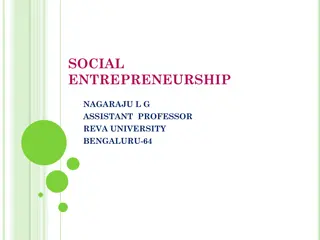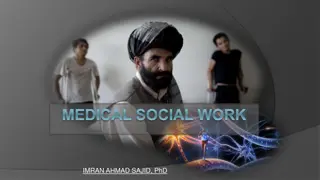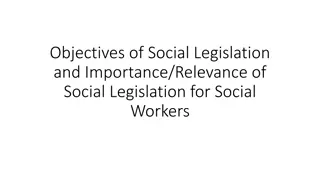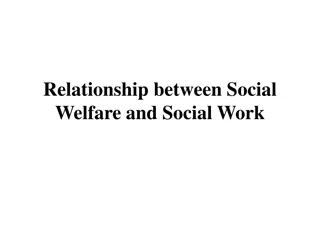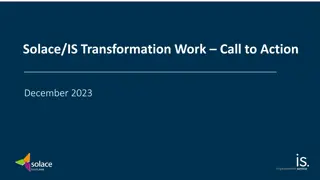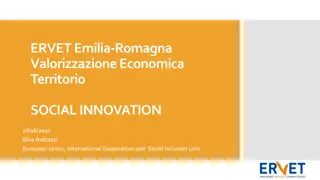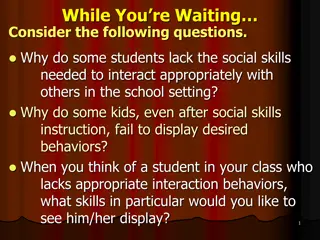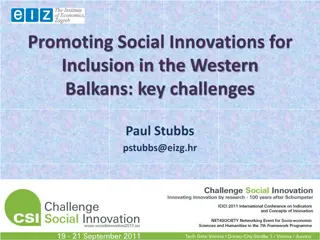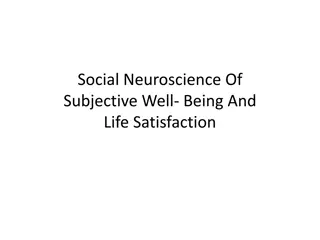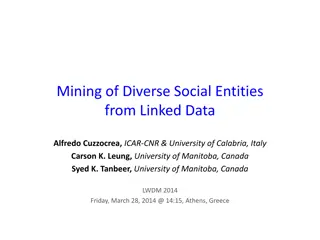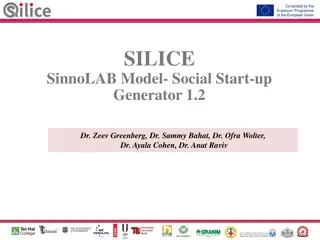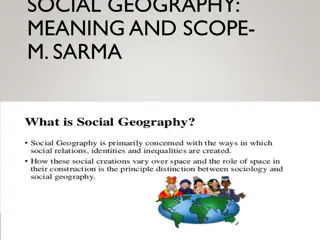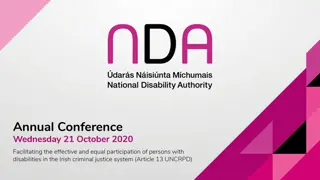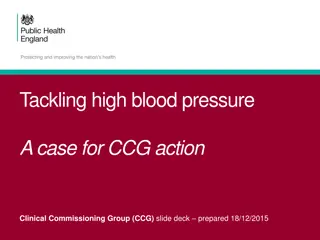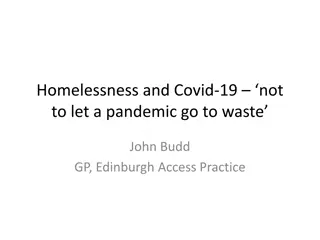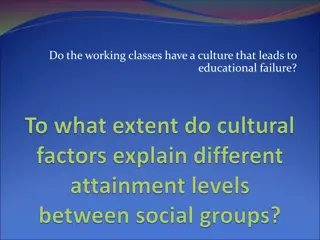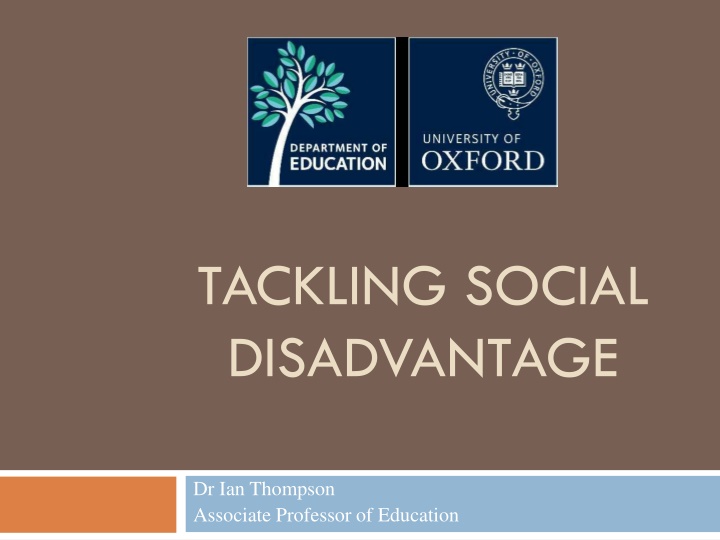
Tackling Social Disadvantage in Education
Explore the challenges faced by schools in narrowing achievement gaps and providing equal opportunities amidst rising poverty and socio-economic disparities. Learn about the long-term impacts of marginalization on youth and society, as well as insights from reports by Unicef and experts on educational well-being and societal equality.
Download Presentation

Please find below an Image/Link to download the presentation.
The content on the website is provided AS IS for your information and personal use only. It may not be sold, licensed, or shared on other websites without obtaining consent from the author. If you encounter any issues during the download, it is possible that the publisher has removed the file from their server.
You are allowed to download the files provided on this website for personal or commercial use, subject to the condition that they are used lawfully. All files are the property of their respective owners.
The content on the website is provided AS IS for your information and personal use only. It may not be sold, licensed, or shared on other websites without obtaining consent from the author.
E N D
Presentation Transcript
TACKLING SOCIAL DISADVANTAGE Dr Ian Thompson Associate Professor of Education
Personal Context English Teacher Practitioner Researcher- PhD Educational Researcher Oxford PGCE Course Director Information Classification: General
The Challenge How can schools narrow gaps in achievement, and ensure all children have access to a wide curriculum, while poverty rises and socio-economic gaps increase? It is unfair and unrealistic to expect teachers to change the society. It is not unfair or unrealistic to expect teachers to change, in part if not wholly, the conditions in which they and their students experience personal and intellectual growth. Seymour B. Sarason (1993) You are thinking of teaching? Information Classification: General
Marginalisation in/from education Has negative long-term consequences for young people in terms of social engagement in the wider world, academic attainment, emotional development, and future employment. Long-term costs for society Information Classification: General
Unicef Innocenti Report (2007) The true measure of a nation s standing is how well it attends to its children their health and safety, their material security, their education and socialization, and their sense of being loved, valued, and included in the families and societies into which they are born. (Unicef, 2007, p.1) Information Classification: General
Unicef: Measures of well-being Material well-being Health and safety Educational well- being Family and peer relationships Behaviours and risks Subjective well- being Card 7: The United Kingdom in the bottom third of the rankings for five of the six dimensions reviewed. Report Card 9 shows slight improvement in UK but very similar trends. Information Classification: General
The Spirit Level (2009, 2010) Richard Wilkinson and Kate Pickett Almost everything-from life expectancy to mental illness, violence to illiteracy- is affected not by how wealthy a society is, but how equal it is. Societies with a bigger gap between the rich and poor are bad for everyone in them. Information Classification: General
Dimensions of child well-being used by UNICEF Material well-being Health and safety Educational well- being Family and peer relationships Behaviours and risks Subjective well-being Card 7: The United Kingdom and the United States find themselves in the bottom third of the rankings for five of the six dimensions reviewed. Report Card 9 shows slight improvement in UK but very similar trends. Information Classification: General
Danny Dorling 27% in England over a quarter (27 per cent) of households are poor Just under a quarter (24 per cent) of all households in England are rich, For the first time ever, a minority of households in England (48 per cent) are neither rich nor poor according to these definitions of poverty and wealth. In the early Eighties 66% of households were in the middle, were neither rich nor poor in England. London: 27% wealthy, 36% middle, 37% poor Information Classification: General
Is there a crisis in English schools? Crisis: a point in time when a dangerous situation contains conflicting forces of an intensity or seriousness that in the near term will be dramatically altered depending on which forces win out (Sarason) . Age of austerity Teacher shortage Recruitment Workload Performance demands (Performativity- Stephen Ball) Information Classification: General
Profile of teachers in England ITE: Increasingly young, white and middle class BME and older candidates decrease Qualified teachers leaving profession before retirement: 22,260 in 2011 to 34,910 in 2016. 100,000 qualified teachers have never taught Huge increases in unqualified teachers Schools spent 56m advertising +62% A level qualified: Maths 75%, Physics 62%, English 78% Pupil increase of 1 million to 2025 (1,900 schools) Information Classification: General
Who suffers in a crisis? Information Classification: General
Research has noted that: UK one of the most unequal societies in Western World Policy solution is devolved (eg pupil premium) Indicators show England performs poorly Educational achievement linked to disadvantage Inequalities surface in pre-school years Gap present when children start school Gap continues & grows throughout school Closing the gap a high policy priority Information Classification: General
The super rich and the politics of inequality Among the top 0.01% are people who fervently believe that inequality is good, that the poor deserve nothing more than to be poor because they do not have it in them to be any better, and that the rich are worth their riches. Dorling, 2014 p.25 Inequality and the 1% Information Classification: General
Cultural Capital v Social-Economic Status The culture of the most powerful classes serves as a legitimate culture that can be mastered to varying extents. Those who have been inculcated in these cultural forms from childhood, and thus have the most cultural capital, will have the greatest probability of academic success and tend to receive the highest grades. Students with working class origins will have disadvantages in the educational system because of the distance between their class culture and the legitimate culture that dominates the school system. But... cultural capital and SES can vary independently. (Bourdieu, 1996) Information Classification: General
Oxbridge: David Lammy 55 times less likely if on Free School Meals Over 80% of offers to most affluent BAME
Educational policy in UK Across the UK policy reforms have been underpinned by dual-commitments to accountability and inclusion. Social justice, social mobility However, in contrast to Scotland, and to some degree Northern Ireland and Wales, commitment to accountability appears to override practices of inclusion in England (ADCS 2018) Performativity, neo-liberalism, neo-conservatism Information Classification: General
Who suffers under performativity? Underperforming teachers Underperforming children SEND Social, emotional behavioural difficulties Language difficulties Low socio-economic status Outsiders Information Classification: General
GCSE performance by free school meals and ethnic background in England, 2008 (5A*-C percentage) (Demi and Lewis, 2010) Ethnic group Non-FSM FSM Chinese 84.9 79 Bangladeshi 65.3 59.2 Pakistani 61.1 51.9 Black Caribbean 57.0 43.3 Black African 65.4 50.2 Indian 79.9 64.1 White and Black Caribbean 59.9 39.5 White and Black African 68.6 45.6 White British 67.1 34.5 Information Classification: General
Ethnicity and Free school meals 5+A*-C EM by ethnic group and entitlement to FSM: England 2013 80% 78% 77% 77% 74% 70% 68% 67% 67% 66% 65% % 5+ A*-C grades including Eng & Maths 61% 61% 60% 59% 59% 60% 58% 57% 52% 51% 49% 50% 48% 47% 44% 43% 42% 40% 38% 32% 30% 20% 10% Source: Strand (2015)
The Will to Punish (Carl Parsons) Information Classification: General
Permanent school exclusions School exclusion is both an outcome of disadvantage and a cause of social and economic inequalities (Daniels and Cole 2010; Power and Taylor 2013; Thompson 2017; Chu and Ready 2018). It can lead to disaffection, social fragmentation and even conflicts (UNESCO 2012) and is cause for concern worldwide UNESCO (2018). The number of permanent school exclusions (PEx) have risen alarmingly in England since 2014 in stark contrast to the other UK jurisdictions e.g 7,720 PEx in England and five in Scotland in 2016/17. Off-rolling County lines Information Classification: General
Disparities within England Within and between local geographic variation Disproportionate over-representation of certain groups of pupils Excluded children are the most vulnerable: twice as likely to be in the care of the state, four times more likely to have grown up in poverty, seven times more likely to have a special educational need and 10 times more likely to suffer recognised mental health problems (IPPR 2017). Information Classification: General
Poverty and Education Poverty and other forms of social disadvantage have deeply harmful consequences for the cognitive, emotional and social development of children. Information Classification: General
Impact of poverty Environmental Psychological unstable and chaotic households; less social support and resources; lack of household space; poor air quality and pollution leading to increased incidents of asthma; more dangerous neighbourhoods; less successful academically and/or less socially mixed schools; lower quality nutrition; poorer quality school buildings. Those experiencing poverty show significantly lower levels of confidence in their own ability to succeed. Poverty increases the risk of mental illnesses as both a causal factor (e.g. stress resulting from poverty) and a consequence of mental illness (e.g. schizophrenic symptoms leading to decreased socio-economic status and prospects); Children raised in environments of low socio- economic status show consistent reductions in cognitive performance across many areas, particularly language function and cognitive control (attention, planning, decision-making); Resource scarcity induces a scarcity mindset , characterised by increased focus on immediate goals at the expense of peripheral tasks and long-term planning. Information Classification: General
Sociology of poverty social class and processes of class reproduction remain important, particularly for the continuity of poverty over time and across generations; it is important to understand the stigma and shame in the experience of poverty. A particular concern is with how the spending patterns of those in the greatest poverty are often subject to stigmatization; the ways in which institutions such as public or welfare delivery services can negatively stereotype those experiencing poverty has also been shown to be important in stigmatising and disadvantaging those experiencing poverty; to a large extent, people s social class positions still influence the opportunities open to them. Starting out life in poverty means a greater risk of poverty in later life. (Shildrick and Rucell, 2015) Information Classification: General
Underlying message? Junk food Mums Sinner ladies Jamie Oliver admits school dinners campaign failed because eating well is a middle class preserve (The Telegraph). Information Classification: General
Possible factors Stereotypes and assumptions Deficit ideology (Paul Gorski) Hard to reach parents Cultural differences Performativity Information Classification: General
Assumptions and Stereotypes Information Classification: General
Deficit models The individual and their background, e.g. poor parenting? "Attributing behavioural problems to poor parenting neatly excuses the school. Teachers usually think there must be something wrong with the child emotionally or psychologically, or that he or she must come from a bad family. Their response is either blame or pity, neither of which is helpful." Gillian Evans High aspirations but low expectations (Lupton, Cummins et al.) Evans's research found that although they "wanted their children to do well and valued formal learning... they see it as something that happens in school, not in the home . Pathologising poverty Information Classification: General
How do you view yourselves? Ethnicity? How do others view you? Gender? Is this offensive or uncomfortable? Social Class? Sexuality? Physical health? Mental health? The way you look? Information Classification: General
How does society view learners? Information Classification: General
Is there hope? Research literacy increase- research informed profession Ofsted: Amanda Spielman announces shift from focus on pupil outcomes through focus on data and compliance to questions of breadth of curriculum Robin Bevan TES: From environment health to restaurant critics Potential unintended consequences BUT also opportunity if based on research Information Classification: General
Outstanding secondary schools (Ofsted 2009) They excel at what they do, not just occasionally but for a high proportion of time. Their achievements do not happen by chance, but by highly reflective, carefully planned and implemented strategies which serve these schools well in meeting the many challenges which obstruct the path to success. They operate with a very high degree of internal consistency. They are constantly looking for ways to improve further. They have outstanding and well-distributed leadership. Information Classification: General
Outstanding secondary schools (Ofsted 2009) They prove constantly that disadvantage need not be a barrier to achievement, and that schools really can be learning communities. They put students first, invest in their staff and nurture their communities. They have strong values and high expectations that are applied consistently. They fulfil individual potential through providing outstanding teaching, rich opportunities for learning, and encouragement and support for each student. They are highly inclusive, having complete regard for the educational progress, personal development and well-being of every student. Information Classification: General
Finland-a learning community Emphasis on play Education, at all levels, free No private education No league tables Only one standardised test (marked by teachers) Teaching high status SEN intervention at point of need Gap between weak and strong lowest in world Information Classification: General
Cognitive-Affective-Social Development ...every function in the child s cultural development appears on the stage twice, that is, on two planes - firstly on the social plane and then on the psychological plane; firstly among people as an inter-psychological category and then within the child as an intra- psychological category. (Vygotsky, 1978 - Translated by Olga Rubtsova) What kinds of learning engages and motivates disadvantaged children? What type of curriculum? Funds of knowledge (Moll) Information Classification: General
Vygotsky continued Rather than understanding a stage of development through the ladder metaphor associated with Piaget, Yaroshevsky (1989) suggests that Vygotsky had a dramaturgical notion in mind when he invoked the word stage . The idea was that of a stage where two planes the personal and the social were in play. When these two planes collided, as a result of incommensurability between personal understandings and social situations, then a reforming of both may occur. (Daniels H. & Downes E., 2015, p.104-105) Information Classification: General
Being Other The creative arts can offer some young people who are perhaps most at risk of becoming disaffected a powerful set of tools for creating contexts that may provide them with the opportunity to re- negotiate identities and hence re-engage with school (Daniels & Downes, 2014; Wallace-DiGarbo & Hill, 2006). Through being Other , in role as artist or actor, the young people work in collaboration with peers and adults to free themselves from the fear of failure and the constraints of their current interactions with the social world (Wright & Rasmussen, 2001). (Tawell et al. 2015, p.4) Information Classification: General
Transforming a Social Situation Information Classification: General


